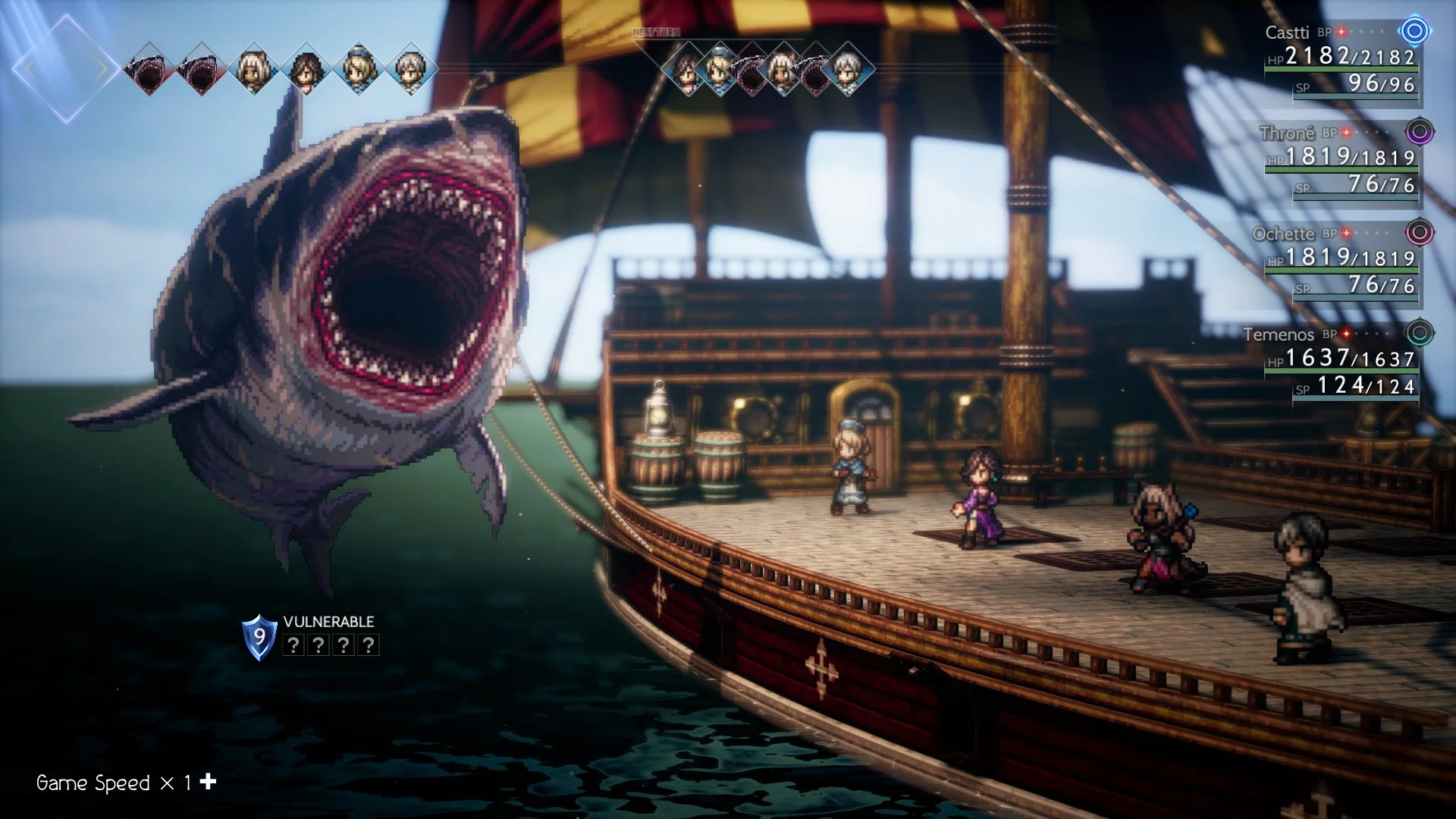Review | Octopath Traveller II - Grind... With A Purpose!
“Pardon me, but would you be able to provide assistance? My wife is about to give birth and while it is an immensely exciting occasion for all of us, I can’t help but be a bit stressed as we need the assistance of our midwife. I believe she was last seen on a pilgrimage to Flamechurch. Any assistance would be very much appreciated.” This is the first side quest I accepted during my journey with Octopath Traveler II. I spent the next several minutes trying to locate this midwife in order to help out the fine gentleman who was relying on me, but unfortunately, I could not find her and I gave up. It wasn’t until much later in the game when I decided to try again (after several in-game days had passed). I eventually found the midwife, guided her to the appropriate destination, and completed the side quest. I’m certain that this man’s poor wife achieved a Guinness World Record plaque for Solistia’s longest labour, but nevertheless, the gentleman viewed me as a hero when it was all said and done and all was right with the world.
This is what side quests in Octopath Traveler II are like. They are obtuse and they rely on the player to utilize the clues given in the brief quest description combined with the overworld abilities of the party members to figure out where you need to go next and how to complete the side quest; there’s no signposting or waypoints. Luckily, that’s not why you come to Octopath Traveler II. Sure, these side quests are there for those who want to be completely absorbed by the world and the NPC’s drama within it, there are also rewards for completing them, and they can even lead to funny anecdotes, but none of it is actually necessary to get the most out of Square Enix’s latest HD-2D JRPG epic. The reason you come to this game is the combat system, the eight unique party members with intertwining stories and abilities, and the frankly stunning look and sound design of this game.
Octopath Traveler II is a traditional RPG with turn-based combat that utilizes the HD-2D engine developed by Square Enix. You start the game by reviewing a brief synopsis for each character along with a description of their specific job class and choose which one you would like to start with. It can feel slightly intimidating as once you make this choice, there is no going back and the character is locked as a permanent party member for the remainder of the game. Even though I am glad that I chose Osvald, the Scholar (I also chose the Scholar in the first Octopath Traveler), all of the characters have endearing qualities and each job is useful. Plus, you will eventually unlock the ability to assign a secondary job class to each of your characters, so it will work itself out no matter who you choose to start with. Just pick the character whose story you connect with the most - or the job class that sounds the most interesting - and move on.
The introductory chapters for each character do a great job of establishing character qualities and motivations and also provided me with enough of a hook to want to see each through to the end. Wanting to complete each character’s story feels especially important when you consider the fact that you will likely spend almost 80 hours of your life with these people. This is helped by the narrative's momentum and the majority of the chapters for each character ending in a cliffhanger that left me wanting more (much like a good book). It became clear about halfway through that I had my favourites and there were a few chapters for certain characters that felt like a slog to get through. That said, thankfully, the chapters are relatively short in length as there is only a handful that last over an hour and the majority of them take about 40-55 minutes to complete. That meant that, even when a certain story wasn’t hitting for me, I was able to get back to the content that I enjoyed the most without sacrificing too much of a time commitment for the content that I didn’t find particularly engaging.
The game’s combat not only continues to be my favourite aspect of the Octopath Traveler series, but it is also what you’ll spend the majority of your time doing. The combat is turn-based and the game provides you with a current turn order (for party members and enemies combined) in the upper left of the screen with the next turn’s order appearing in the upper middle of the screen. The turn order is different each time you start a battle, which keeps things feeling fresh and is another huge positive for a game this long.
HD-2D in all its glory.
Each enemy has a certain number of weaknesses - either elemental or a specific weapon - that are hidden until you hit them with it or use a Scholar ability that reveals one weakness each time you use it in battle. The enemies also have shields that require you to exploit their weaknesses a set number of times before you break them. Breaking your enemies allows you to inflict more damage and also causes the enemy to forfeit their next turn. Although your characters and the enemies can also utilize a variety of buffs and debuffs, the other main aspect of combat is boosting. Each party member has boost points (BP) that can be stacked and then used later to increase the damage/number of attacks dealt and also the potency of healing. Each character has their own latent ability that charges during battle and can be activated when the gauge is full, which adds a new wrinkle to combat as this is a combat mechanic that was not present in the first game.
The key to combat is deciding when and how to best use your BP while utilizing the turn order and your character abilities to your advantage and trying to break the enemies to prevent them from upcoming turns and to deal maximum damage. In battle, I was careful to utilize each character’s latent ability to maximize my combat efficiency. I found the combat was at its best when I slowed down and thought several moves ahead. The layers that both BP and latent skill adds means combat feels much more tactical than other JRPGs, where once you find an enemy’s weakness you just spam it until they die. Planning moves ahead, stacking BP, and timing your latent moves is immensely rewarding and nailing it all to kill a tough enemy feels like your master plan is coming together.
My only gripe with the combat is that some of the endgame bosses feel almost unfair in the abilities that they can use. After hours of tactics and timing attacks, I found myself throwing strategy out the door in favour of using items or certain overpowered abilities to bail myself out of sticky situations.
The freedom of team building is another standout element of Octopath Traveler II. Each character has a primary job class that cannot be changed, but as you uncover the variety of other jobs that are available, you can assign each character a secondary job as well. You can only have one character assigned to a specific job class at a time, but you can freely switch between them at any time. Each job has combat skills and support skills that can be unlocked by obtaining job points (JP) that are earned after each battle. Combat skills can only be used when the character is assigned to the corresponding job class, but support skills can be set at any time once they are unlocked, up to a maximum of four at a time for each character. I had so much fun finding out which combat and support skills could be unlocked, which ones made the most sense for each character according to their base stats, and finding the optimal combinations of skills and party members suited for my particular playstyle.
Look at that water!
The game’s style can also not be understated, Octopath Traveler II looks absolutely gorgeous and it sounds incredible as well (it’s excruciating to me that the OST isn’t available on streaming services yet). These elements were present in the first game, but seem to be refined in the years since as Aspire gets more adept at getting the most out of this nostalgia-filled engine. It isn’t just the pixel art in a 3D environment but the environmental lighting and the particle effects that give combat an extra punch. It is also worth noting that the HD-2D artstyle really popped on my Switch OLED and even though the game is on PC and PlayStation, I could help but be reminded of classic GBA JRPGs playing in handheld mode.
Yum. Fried bandit.
If you think it looks good in stills, trust me when I say that the game looks even better in motion. While the lighting and particle effects might be flashy, the sprites of enemies, and bosses in particular, have an exceeding amount of detail that rarely ceased to amaze me.
Jaws (1975)
Dir: Steven Spielberg
An important thing to note for those who may be intimidated by the length of games like this is that you do not need to play the first Octopath Traveler in order to enjoy the second as they are completely standalone games. Additionally, for those like me who lead busy lives and struggle to make time for games, the overall structure of Octopath Traveler II is perfect for fitting it into your life with ease. Each character’s story is split into different chapters, which allows for an easy way to separate play sessions. By going into the start menu, you can also choose to read a summary of each chapter or view cutscenes again if you take an extended break from the game and find that you need a refresher on what is going on in the story.
The issues that I have with Octopath Traveler II ultimately feel like nitpicks as there are so many aspects of the game that make it a masterclass of an RPG and a significant improvement upon its predecessor. It looks fantastic and sounds even better. It's deep enough for RPG veterans to have a good time while also being welcoming for newcomers to the genre. Furthermore, it has a friendly structure that allows those with busy lives to easily make time for it. Just play it already.










